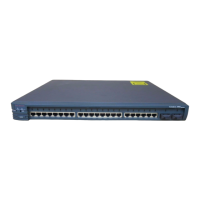112 Cisco LAN Switching Configuration Handbook
CST and PVST. PVST bridge protocol data units (BPDU) are tunneled over an
802.1Q trunk. Catalyst switches run PVST+ by default.
■ Rapid-PVST+ is a hybrid STP mode that uses IEEE 802.1w (Rapid Spanning Tree)
combined with a per VLAN basis. This mode is compatible with IEEE 802.1w but
uses a Cisco extension to allow per-vlan spanning tree.
■ Multiple Spanning Tree (MST), based on the IEEE 802.1s standard, extends the
802.1w Rapid Spanning Tree Protocol (RSTP) to have multiple STP instances.
■ MST is backward compatible with 802.1D, 802.1w, and PVST+ STP modes.
■ Switches configured with common VLAN and STP instance assignments form a
single MST region.
■ MST can generate PVST+ BPDUs for interoperability.
■ MST supports up to 16 instances of STP.
■ Switches send BPDUs out all ports every Hello Time interval (default 2 seconds).
■ BPDUs are not forwarded by a switch; they are used only for further calculation and
BPDU generation.
■ Switches send two types of BPDUs:
■ Configuration BPDU
■ Topology change notification (TCN) BPDU
Note Standard BPDUs are sent to the well-known STP multicast address 01-80-c2-00-00-
00, using each switch port’s unique MAC address as a source address.
STP Process
1. Root bridge election: The switch with the lowest bridge ID becomes the root of the
spanning tree. A bridge ID (BID) consists of a 2-byte priority and a 6-byte MAC ad-
dress. The priority can range from 0 to 65535 and defaults to 32768.
2. Root port election: Each nonroot switch elects a root port, or the port “closest” to
the root bridge, by determining the port with the lowest root path cost. This cost is
carried along in the BPDU. Each nonroot switch along the path adds its local port
cost of the port that receives the BPDU. The root path cost becomes cumulative as
new BPDUs are generated.
3. Designated port election: One switch port on each network segment is chosen to
handle traffic for that segment. The port that announces the lowest root path cost in
the segment becomes the designated port.
4. Bridging loops are removed: Switch ports that are neither root ports nor designated
ports are placed in the blocking state. This step breaks any bridging loops that would
form otherwise.
